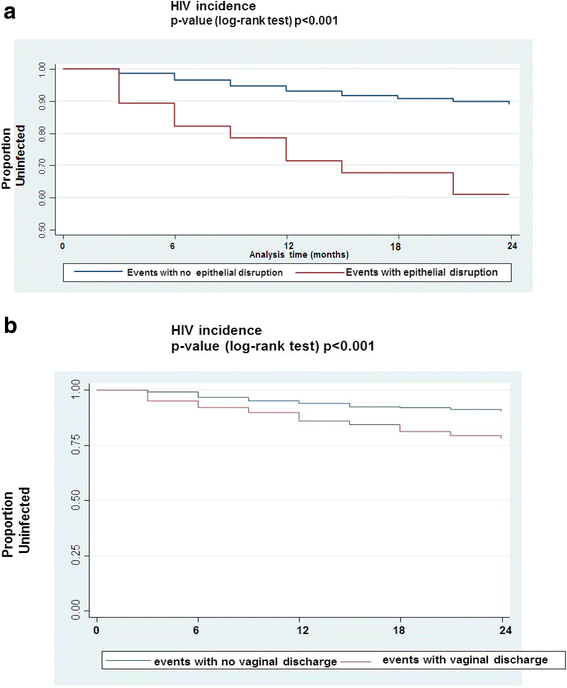Biological factors that place women at risk for HIV: evidence from a large-scale clinical trial in Durban
- PMID: 26992693
- PMCID: PMC4799526
- DOI: 10.1186/s12905-016-0295-5
Biological factors that place women at risk for HIV: evidence from a large-scale clinical trial in Durban
Abstract
Background: It is well documented that the mucosal linings of the female genital tract (FGT) usually provides a robust barrier that protects against sexually acquired infections. However, to the best of our knowledge there are limited South African studies that have investigated the association between damage to the mucosal linings and the acquisition of HIV infections. We hypothesize that in this cohort of women, a higher rate of HIV seroconversions will be observed for women who present with evidence of mucosal damage.
Methods: We undertook a secondary analysis of the Methods for Improving Reproductive Health in Africa (MIRA) trial that assessed the effectiveness of the latex diaphragm and lubricant gel on HIV prevention among women. Participants underwent a physical examination which included a pelvic examination to detect the presence of mucosal abnormalities. During the physical examinations, the study clinicians examined the genitalia, cervix and vagina for signs of epithelial disruptions and abnormal vaginal discharge. The association between the various genital factors and HIV seroconversion was modeled using Cox proportional hazards regression analysis.
Results: In this cohort of 1485 women that had enrolled to participate in the study, women that had presented with genital epithelial disruptions and abnormal vaginal discharge were shown to be at highest risk for HIV acquisition (Hazard Ratio (HR): 4.30, 95% CI: 2.25, 8.22, p <0001, HR: 2.37, 95% CI: 1.69, 3.33, p <0.001) respectively. In addition, the Kaplan Meier analysis showed that the highest number of seroconversions was observed in women that had disrupted genital epithelia (27 per 100/py, 95% CI: 15.0, 50.7) and abnormal vaginal discharge (12 per 100/py, 95% CI: 9.70, 16.7). Other significant factors included: genital signs and symptoms (HR: 1.67, 95% CI: 1.07, 2.61, p = 0.02) and genital ulcers/sores (HR: 1.79, 95% CI: 1.05, 3.06, p = 0.03).
Conclusion: We have shown that damage to the mucosal epithelial lining increases a women's risk of HIV seroconversion. Future studies that provide an in depth understanding of the mechanisms associated with the FGT and mucosal immunity will be most valuable. An understanding of all of these mechanisms will be key in directing the advancement of products most suitable for combating HIV infection in women.
Trial registration: This study was registered with ClinicalTrials.gov,number NCT00121459 on the 28th February 2007.
Keywords: Abnormal vaginal discharge; Epithelial disruption; HIV infection; Sexually transmitted infections.
Figures
References
-
- Hickey DK, Patel MV, Fahey JV, Wira CR. Innate and adaptive immunity at mucosal surfaces of the female reproductive tract: stratification and integration of immune protection against the transmission of sexually transmitted infections. J Reprod Immunol. 2011;88(2):185–194. doi: 10.1016/j.jri.2011.01.005. - DOI - PMC - PubMed
Publication types
MeSH terms
Substances
Associated data
LinkOut - more resources
Full Text Sources
Other Literature Sources
Medical


